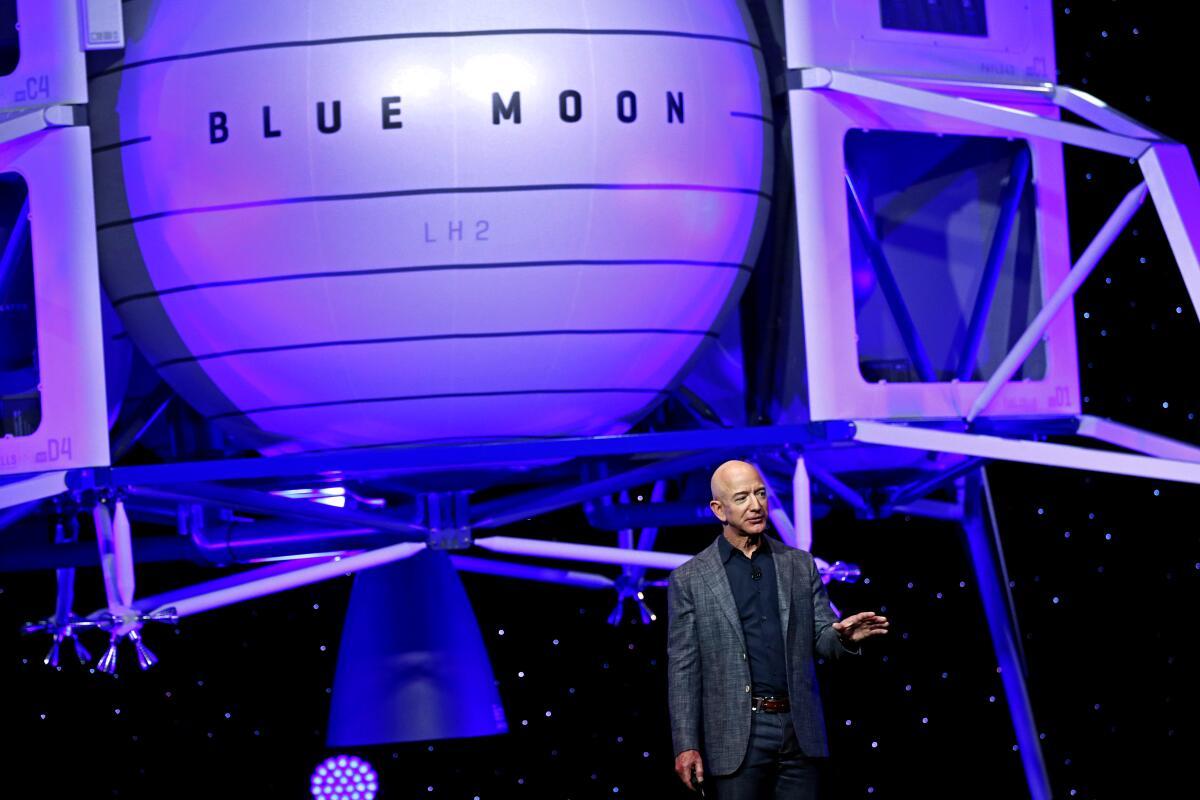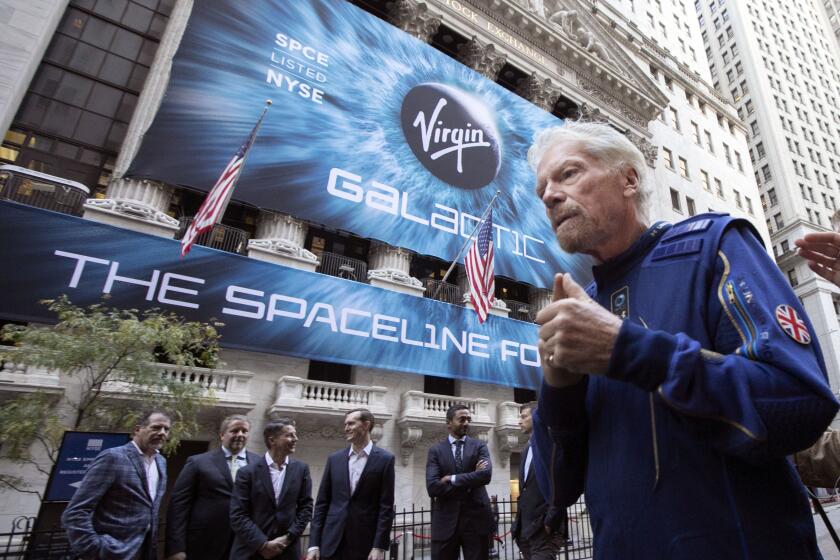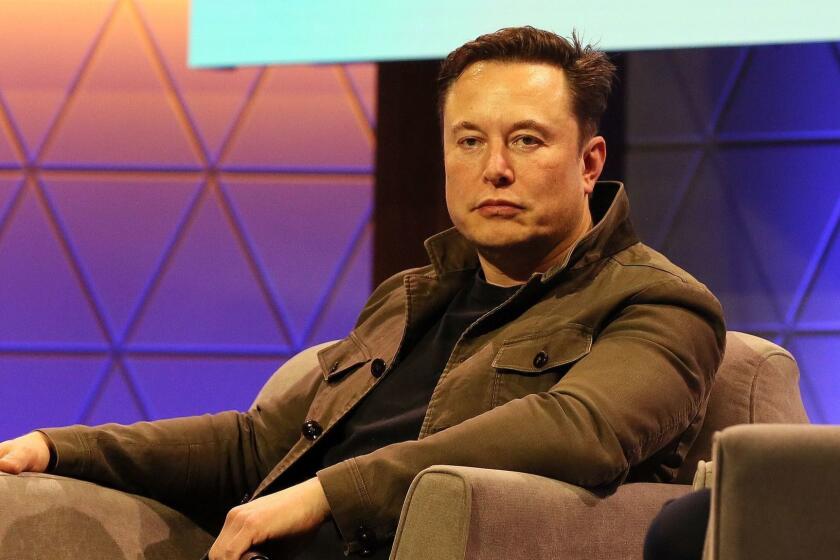Column: In billionaires’ space race, tourism is a sideshow to quest for moon landing contracts

- Share via
The space race among billionaires Richard Branson, Jeff Bezos and Elon Musk reached a milestone of sorts Sunday when Branson rode a Virgin Galactic craft some 50 miles high into the wild blue yonder, launching what he called a world of “equal access to space” for people of any age, gender or ethnicity.
Don’t be fooled. The real target of these entrepreneurs’ efforts isn’t the small customer base of individuals rich enough to afford five- or six-figure thrill-ride tickets. It’s the billions of dollars to be spent by the U.S. and other governments on satellite and crewed exploration missions.
For the moment, popular attention appears to be focused on the billionaires’ launches; Bezos is scheduled to take a suborbital flight via the New Shepard launch vehicle of his Blue Origin spaceflight company July 20. (The craft is named for Alan Shepard, the first U.S. astronaut in space.)
I’m skeptical that this is a big business opportunity. It’s pretty much a niche market for wealthy individuals and adventure-seekers.
— Space expert John Logsdon, on the potential for space tourism
The holy grail of these endeavors is NASA’s plan to return crewed spacecraft to the moon, on which no human has set foot for 49 years, or since the last Apollo mission.
Dubbed Artemis after the twin sister of Apollo in Greek mythology, the program is aimed at reaching the moon before this decade is out and keeping a team on the surface for a sustained period.
Get the latest from Michael Hiltzik
Commentary on economics and more from a Pulitzer Prize winner.
You may occasionally receive promotional content from the Los Angeles Times.
For the private companies tapped to participate, the harvest could be impressive: In April, NASA’s inspector general estimated that the space agency could spend as much as $86 billion on Artemis by the end of fiscal 2025, assuming that Congress appropriates the money. Tens of billions of dollars more would flow as the program moves toward its goal in subsequent years.
By contrast, experts believe that the market for individual space tourism is limited. “I’m skeptical that this is a big business opportunity,” John M. Logsdon, a professor emeritus at George Washington University and founder and long-term director of its Space Policy Institute, told me. “It’s pretty much a niche market for wealthy individuals and adventure-seekers.”
It’s also relatively undemanding in technical terms. Branson’s suborbital flight, which lasted about 15 minutes and afforded its four-person crew and two pilots about three minutes of weightlessness, required the craft to reach a speed of about Mach 3, or three times the speed of sound; an orbital flight would have required a speed of about Mach 17, Logsdon says.
And for all that Branson marked his flight’s apogee with an exhortation to “the next generation of dreamers: if we can do this, just imagine what you can do,” the first American suborbital flight, lasting about as long as Branson’s, was achieved by the baby boom generation. That flight, carrying Shepard, took place in 1961, or 60 years ago.
Virgin Galactic is competing with Amazon founder Jeff Bezos’ Blue Origin and Elon Musk’s SpaceX for a foothold in the space tourism market, for whatever that’s worth. Blue Origin and SpaceX are also in an intense battle with each other and United Launch Alliance, a joint venture of Boeing and Lockheed Martin, for government spaceflight contracts. (Blue Origin is also producing rocket engines for ULA.)
Artemis isn’t the only government program issuing contracts to private spaceflight companies; there’s also competition for satellite launches and for carrying crew and payloads to the International Space Station. But the moon program is NASA’s most ambitious and the one most likely to attract public attention to the contractors.
An effort to be the first billionaire in space is the biggest vanity project in history.
As a result, Artemis is also the program most racked by intercorporate hostility and intrigue.
Most of the conflict has involved SpaceX and Blue Origin. Virgin Galactic hasn’t been a bidder on the moon project, though it was awarded part of a $45-million NASA contract to carry test payloads on its commercial flights.
A sister company in Branson’s corporate empire, Virgin Orbit, completed its first commercial mission June 30. In that flight a Virgin Orbit craft placed seven satellites in low Earth orbit for three customers, including the U.S. Defense Department, which awarded the company a $35-million contract in 2017.
The rivalry for government contracts among the other companies isn’t hard to fathom. “The contracts are absolutely crucial because developing spaceflight isn’t cheap,” says Michael Listner of the consulting firm Space Law & Policy Solutions. “Otherwise they’d have to raise that money on their own, and that’s probably not going to happen. So they need these government contracts to actually survive.”
One problem all the moonshot rivals face is that Artemis is, at this moment, rather half-baked. Originally conceived in 2017 with the goal of placing a crew on the moon by 2028, its deadline was moved up to 2024 by the Trump White House only two years after the program was established. That’s a timeline that most experts say is unattainable.
Last December, Elon Musk, the founder of SpaceX, spent an hour closeted with then-Deputy Defense Secretary Patrick Shanahan.
The Government Accountability Office reported in May that the accelerated schedule made it less likely that a lunar landing could happen in 2024, in part because many project components won’t be ready. “Most of the lunar projects are still early in development and some are relying on immature technology,” the GAO found.
Among other issues, the Gateway, a moon-orbiting outpost from which surface missions will be staged, would “rely on power and propulsion technology that has never before been used,” the GAO said, adding that contractors are behind schedule developing the needed technology.
The Biden administration, which supports the Artemis program, hasn’t taken an explicit position on the deadline, though many believe that the administration will treat 2024 as an “aspirational” goal while redirecting the program toward a later landing.
Squabbling among the contractors and between them and NASA hasn’t helped. Nor have the conflicts been confined to the NASA program. In 2018, Musk clashed with the Defense Department over contracts totaling more than $2.2 billion for a series of military rocket launches starting in 2022.
The contracts were divided up among ULA, Northrop Grumman and Blue Origin, with SpaceX completely shut out. SpaceX filed a lawsuit asserting that the awards were the product of “prejudicial unequal treatment” by the Air Force. The case was thrown out last year by a federal judge in Los Angeles.
Wrangling between Blue Origin and SpaceX, possibly animated by personal hostility between Bezos and Musk, has become almost a permanent feature of spaceflight contracting. As long ago as 2015, the two billionaires, who are among the richest individuals on Earth, battled each other over a patent awarded to Blue Origin for landing reusable rockets on a barge in the ocean. SpaceX challenged the patent as unoriginal and won a split decision.
In April, after NASA awarded a $2.9-billion contract for a lunar lander to SpaceX, Blue Origin filed a protest that has prevented NASA from finalizing the award. (A final decision is expected next month.)
With this perspective, it seems evident that the race to shoot tourists into space is all about public relations. The main effect of the Branson flight, Logsdon says, was “all the free publicity it got for an emerging business” through wall-to-wall television coverage and front-page newspaper articles.
Space exploration aficionados experienced the thrill of anticipation in the hours before President Trump’s speech Tuesday night, with advance word that he was going to call for a return to the human exploration of space.
Bezos, reduced to an also-ran in the billionaire-in-space rivalry, is trying to seize center stage by including Wally Funk, one of 13 women selected as the nation’s first female astronauts for Project Mercury, as a crewmate. (None of the 13 ever made it into space.)
The unasked question is how much value lies in crewed exploration of the moon beyond PR. The seven scientific priorities of Artemis as set forth by NASA — such as “observing the universe in a unique location” and “conducting experimental science in the lunar environment” — are almost all achievable by robots and other technology, at less cost and far greater safety than placing crews on the surface. The exception is “investigating and mitigating exploration risks to humans,” which obviously wouldn’t be necessary if humans were not on hand to be exposed to those risks.
The reality of space programs turns an old astronauts’ proverb (popularized by Tom Wolfe’s book “The Right Stuff”) on its head. The original version, alluding to a comic book space hero of yore, was “No bucks, no Buck Rogers,” meaning that without lavish infusions of money, there would be no heroism to celebrate.
What Branson and Bezos are counting on is the opposite — the need to celebrate individuals in space to acquire funding in the first place. In other words, “No Buck Rogers, no bucks.”
More to Read
Get the latest from Michael Hiltzik
Commentary on economics and more from a Pulitzer Prize winner.
You may occasionally receive promotional content from the Los Angeles Times.













